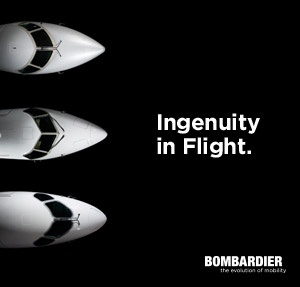Cessna Offers European Union ETS Registration Support for Citation Owners
August 10, 2009
WICHITA, Kan., Aug. 10, 2009 Cessna Aircraft Company, a Textron Inc. (NYSE: TXT) company, today announced a new Internet site at www.cessna.com to guide business jet operators through the process of registering their aircraft for flights in European airspace to comply with the European Union’s aviation Emissions Trading Scheme (ETS), set to take effect in 2012. The deadline for the application for free allocations is August 31.
Under ETS, owners of aircraft with a takeoff weight of more than 12,566 pounds (5,700 kg) who regularly fly their aircraft to EU countries must begin reporting annual emissions starting in 2010, and by 2012 must use carbon allocations for all flights in EU airspace. Operators already identified by the EU are required to register an annual and specific emissions plan. Cessna recommends that operators who plan to begin operations into EU airspace next year register as well, and at the same time qualify for free allocations to lower planned emission fees. Without free allocations, operators have to purchase or trade for allocations.
“There are a lot of moving pieces in this program and we want to do what we can to ensure Cessna operators are, at the minimum, registered in time to qualify for allocations,” said Tom Grace, Cessna director, Technical Information Services. “We also are developing monitoring programs available to Cessna operators to keep them in compliance.”
Citations covered by the new EU directive (more than 12,566 lbs) are the Citation CJ3, Citation II, Bravo, S/II, V, Ultra, Encore and Encore+, Excel, XLS, XLS+, III, VI, VII, Sovereign and Citation X.
COLOMBIA TO INVEST $11 BILLION IN INFRASTRUCTURE
August 10, 2009
Colombia’s Minister of Transportation, Andres Uriel Gallego announced that the country will invest $11 billion in eleven specific infrastructure projects. The government will invest $5.5 billion with the balance coming from the private sector. He also stated: “We are in the process of consolidating our search for resources to develop the projects”. A good part of the infrastructure will be the establishment of a fund which will manage the profits of ISA (Interconnection Electrical S.A.) and Ecopetrol which are being proposed by president Alvaro Uribe which will be handled by Bancoldex. One of the principal projects will be the development of the highway between the border of Panama to the border of Venezuela.
Mintzer Group plans to launch a new cargo airline in Peru
August 10, 2009
The US based group, which offers general sales agency services and investments has announced that it plans to apply for a certificate to operate a cargo airline to be based in Lima, Peru. The principal advisor to the group, Roger Huaman, has stated: “The idea is to offer air cargo services domestically in Peru as well as connections to and from the United States.”
Inauguration of the new terminal at Montevideo’s Carrasco Airport
August 10, 2009
The inauguration of the new $165 million terminal at the Carrasco Airport is scheduled for October 5. The project has taken three years and was designed by the well known Uruguayan architect Rafael Vinoly. According to Portal del Uruguay, it is one of the largest infrastructure projects in the country. It includes extending the runways and building a great passenger-friendly terminal. It is part of the government’s efforts to support the development of Montevideo as a major airline hub in South America.
Avianca’s cargo business takes off in 2009
August 10, 2009
The airline reports cargo revenues in the first quarter of 2009 represents 17% of the total revenue generated by the Synergy Group’s Colombian affiliate, up from 5% in 2008. This is the direct result of the airline’s acquisition of all cargo carrier, Tampa Cargo. This has also helped it to obtain Double A rating for its bond issuing from Fitch Ratings Colombia.
Pluna to operate between Santiago and Punta Arenas in Chile
August 10, 2009
The new service would be an overnight flight from Santiago’s Merino Benitez Airport to the southern point in Chile. It plans to increase its current 11 weekly flights between Montevideo and Santiago to 14 in order to provide the availability of the overnight aircraft to Punta Arenas. It plans to offer cargo as well as passenger service.
Dassault’s Falcon 7X Approved for Steep Approach Landings by the FAA
August 10, 2009
First Long Range Business Jet with Direct Access to Challenging London City Airport
from Virtually Anywhere in the Continental U.S.
(Teterboro, New Jersey, August 10, 2009) – Dassault Falcon has received approval from
the Federal Aviation Administration (FAA) to perform steep approaches with slopes up
to 6° for the Falcon 7X. This approval allows U.S.-based Falcon 7X operators to fly
directly into London City Airport (LCY), Lugano, Switzerland (LUG) and other airports
requiring steep approach landings.
“Business aviation is all about the need for efficiency and access to hard to reach places
and an airport like London City combines the two,” said John Rosanvallon, President and
CEO of Dassault Falcon. “Direct access to this important financial center is sure to
benefit our U.S. based Falcon 7X customers, allowing them to be in meetings moments
after landing.”
The 5,950 nm Falcon 7X offers more range capability than any other business jet
approved for London City Airport. The Falcon 7X can connect business hubs such as
New York, Los Angeles, Mexico City, Sao Paulo, Cape Town and Tokyo with the heart
of London nonstop (eight passengers, M.80, NBAA IFR Reserves).
To operate to and from London City Airport, an aircraft must demonstrate exacting
performance in order to approach, land and take-off on the airport’s short runway (4,327
ft/1,319 m at landing and 3,934 ft/1,199 m at take-off). It also has to meet strict
environmental standards with respect to aircraft noise. In the case of the Falcon 7X, the
noise level was measured in the same category as a much smaller turboprop.
The Falcon 7X was first granted steep approach certification from the European Aviation
Safety Agency (EASA) in 2008 and received full EASA approval for flights into London
City in February of this year. Approval by both EASA and the FAA required dedicated
flight tests and the development of Noise Abatement Departure Procedures.
In order for an operator to perform a steep approach, the flight crew must undergo oneday
of specialized training. A steep approach pilot training curriculum was developed in
conjunction with CAE and is currently offered at its Burgess Hill facility in the United
Kingdom and will be offered shortly at their Morristown, New Jersey facility in the
United States. Dassault is in the process of issuing an amendment to the Aircraft Flight
Manual which will outline proper data and procedures for steep approach operations.
Announced at the Paris Air Show in 2001, the Falcon 7X is the first business jet with a
digital flight control system and was simultaneously certified by both the EASA and the
FAA on April 27, 2007. It features the award-winning EASy Flight Deck and is powered
by three Pratt & Whitney Canada PW307A engines. Its 5,950 nm range (eight
passengers, M.80 with NBAA IFR reserves) can comfortably connect 95% of the
commonly used business aviation city pairs.
A Air China Lança o Primeiro Cartão para Business Travel da China
August 7, 2009
BEIJING, 7 de agosto /PRNewswire-Asia/ -- A Air China lançou o 'Air China
Business Travel Card', tornando-se a primeira companhia aérea da indústria da
aviação civil chinesa a introduzir tal tipo de serviço.
Para satisfazer as necessidades dos passageiros que viajam a negócios, a
Air China integrou os serviços oferecidos pelos seus programas de comércio
eletrônico e milhagem para lançar o 'Air China Business Travel Card'. Existem
quatro tipos disponíveis de cartão -- O Distinguished Travel Card, o Clear
Travel Card, o Smooth Travel Card e o Easy Travel Card. Estes cartões podem
ser usados para armazenar crédito, reservar passagens, ganhar milhas de
viajante frequente e usar os serviços de cortesia. Os cartões vêm com valores
de crédito entre RMB20.000 e RMB300.000.
A Air China introduziu diversas promoções e versões com edição limitada
dos cartões para viagens a negócios. Os primeiros 99 clientes que comprarem um
cartão Distinguished Travel Card de edição limitada, receberão uma passagem de
cortesia ida-e-volta, em primeira classe, a qualquer destino internacional da
Air China. Os primeiros 500 clientes que adquirirem um cartão Distinguished
Travel Card de edição limitada, receberão um cartão de milhagem Gold
PhoenixMiles.
Os primeiros 199 clientes que comprarem um cartão Clear Travel Card de
edição limitada, receberão uma passagem de cortesia ida-e-volta, em primeira
classe, a qualquer destino doméstico da Air China. Os primeiros 1000 clientes
que adquirirem um cartão Clear Travel Card de edição limitada, receberão um
cartão de milhagem Silver PhoenixMiles.
Os primeiros 299 clientes a comprarem um dos 10.000 cartões Smooth Travel
Card de edição limitada, receberão uma passagem de cortesia ida-e-volta, em
classe econômica, a quaisquer dos destinos domésticos da Air China, mais um
crédito de cortesia RMB3.000.
Os primeiros 399 clientes a comprarem um dos 200.000 cartões Easy Travel
Card de edição limitada, receberão uma passagem de cortesia só de ida, em
classe econômica, a quaisquer dos destinos domésticos da Air China, mais um
crédito de cortesia de RMB1.000.
A promoção é válida de 6 de agosto de 2009 até 31 de Dezembro de 2009. Os
passageiros podem telefonar para +86-4008-986-999 e pressionar a opção 6 para
adquirir o Business Travel Card. Uma vez feito o pedido, o cartão pode ser
usado a partir de 16 de Setembro de 2009. Quando acabar o crédito do cartão,
ele pode ser recarregado. Se o cartão for perdido, um novo cartão será emitido
no escritório de vendas da Air China que for indicado.
BLR Winglets are Key Upgrade in New Beechcraft King Air 90x Package
August 7, 2009
Everett, WA, Aug. 7, 2009 — A new Beechcraft King Air upgrade package from Hawker Beechcraft Services (HBS) is good news for King Air C90/E90 operators and for BLR Aerospace.
Speak with BLR representatives in Exhibit No. 5116 (Static Display Area) at the Latin American Business Aviation Conference & Exhibition (LABACE) Aug. 13-15 in Sao Paulo, Brazil.
HBS recently announced that it is offering a Beechcraft King Air 90x upgrade package, including BLR Aerospace winglets, to enhance handling and performance for King Air C90 and E90 aircraft. The HBS upgrade package also includes a gross weight increase.
“We congratulate Hawker Beechcraft Services on its new product launch,” said Dave Marone, vice president of Sales and Marketing for BLR Aerospace. “We are proud to support this fine organization and its legendary King Air product line.”
Already certified and installed on the King Air 200, King Air 200GT, and King Air 300, winglet systems deliver impressive improvements in stability, cruise speed, and rate of climb. Approximately 190 systems have been delivered to date. Winglets also deliver a range of financial benefits, including reduced fuel consumption, tax deductions, and increased resale value.
The winglet system increases wing aspect ratio to reduce induced drag, allowing the King Air to fly faster on less fuel. By increasing wing surface area, the winglet system provides superior handling qualities during slow flight speed and at higher flight levels.
The BLR King Air 90 winglets are sold exclusively in the United States through the 10 HBS locations. For more information, visit www.hawkerbeechcraftservices.com.
About BLR Aerospace
BLR designs, develops, manufactures and markets airframe aerodynamic enhancements for fixed-wing and rotary-wing aircraft. BLR’s history of aerodynamic innovation has produced over 60 FAA STC approvals for after-market aircraft modifications. The company’s primary product lines involve airflow manipulation technologies; winglets, vortex generators, FastFin™ and Dual Tailboom Strakes, and specially designed products all aimed at improving aircraft performance.
Prototype Assembly Looms As First Production Parts Arrive for CH-53K Heavy Lift Helicopter
August 7, 2009
STRATFORD, Conn., Aug. 6, 2009 – Sikorsky Aircraft Corp. has begun receiving the first of the 8,500 supplier parts that will constitute the new CH-53K heavy lift helicopter Sikorsky is developing for the U.S. Marine Corps. Arrival of the parts – primarily transmission gear forgings that Sikorsky machinists will intricately refine – indicates steady and solid progress toward production of the first prototypes. Sikorsky Aircraft is a subsidiary of United Technologies Corp. (NYSE: UTX).
“The arrival of the first forgings is a significant and visible milestone for the program,” said John Johnson, CH-53K Helicopter Program manager. “It means the program is advancing from the ‘paper’ stages of engineering and design to the hardware stages of castings and forgings. It is exciting to see such an impressive aircraft start coming to life with these forgings for the dynamics system.”
The parts will support assembly of the seven prototype vehicles that will be delivered during the system design and development program. Of the seven, four will serve as engineering development vehicles. The remaining three will serve as a dedicated ground test vehicle, a static test article, and a fatigue test platform. The prototypes will be assembled at Sikorsky’s Development Flight Center in West Palm Beach, Fla.
The CH-53K will replace the current three-engine Sikorsky CH-53E SUPER STALLION™ helicopter. The CH-53E helicopter is currently the largest, most powerful marinized helicopter in the world. It is deployed from Marine Corps amphibious assault ships and land bases to transport personnel and equipment, and to carry external (sling) cargo loads.
The CH-53K helicopter will nearly triple the payload to 27,000 pounds transportable over 110 nautical miles under “hot high” operational conditions. It will maintain the same footprint as the CH-53E and have significantly lower operational costs. The CH-53K helicopter’s maximum gross weight (MGW) will increase to 74,000 pounds, versus 69,750 pounds for the CH-53E aircraft, and it will be capable of carrying an external load of up to 88,000 pounds as compared to 73,500 pounds for the CH-53E helicopter.
This new build helicopter will incorporate a joint interoperable glass cockpit with fly-by-wire flight controls; fourth generation rotor blades with anhedral tips; a low-maintenance rotorhead; new GE38-1B engines; a 15 percent increase in cabin size; a cargo rail locking system; external cargo handling improvements; survivability enhancements; and reduced operational and support costs.
“The CH-53K helicopter is the only aircraft that meets the Marine Corps’ requirements for heavy lift. It will provide significant improvement in operational capability and significant reduction in cost of ownership. This aircraft also will operate in ‘hot high’ conditions, all of which translates to a critical tool for the Marine Corps,” Johnson said.
Sikorsky Aircraft received a $3 billion System Development and Demonstration contract on April 5, 2006 to develop a replacement for the U.S. Marine Corps CH-53E heavy lift helicopter. The program is expected to produce more than 200 new aircraft.
The CH-53K helicopter team has successfully conducted several risk reduction initiatives on two critical technologies – split torque main gearbox and main rotor blade – and has implemented many process and product improvement measures as a result. The program conducted a successful Preliminary Design Review in September 2008, and is tracking toward a Critical Design Review in 2010.
“We are pleased with the current performance of our team and partners,” said Mark Cherry, Vice President of Marine Corps Systems. “The receipt of these first parts is validation of our development process.”
<






